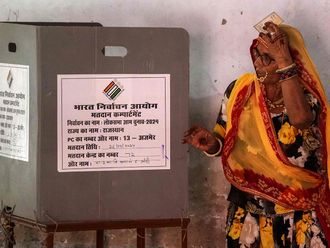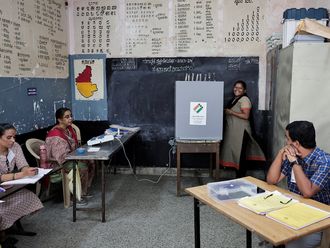The economy rebounded; exports and imports declined, foreign-exchange reserves grew; coal production, electricity generation and petroleum consumption rose, non-performing assets (NPAs) in banking soared. There are great similarities between Prime Minister Narendra Modi’s first year in office — which he completes on May 26 — and the corresponding first year of his predecessor Manmohan Singh. Modi carries Singh’s economic legacy which later worsened considerably, attributed by observers to a global downturn and misgovernance. If the surface indicators were considered, it would be obvious that the dice was heavily loaded in Modi’s favour. Following indicators, analysed by independent data evaluation agency Indiaspend, offer a broad statistical evaluation of the first years of Modi and Singh in office.
Narendra Modi, Indian Prime Minister
1. Foreign visits: Modi is executing his ‘fast-track diplomacy’ with gusto. He has been abroad for 53 of 365 days in 17 countries during his first year as PM.
2. Economic Growth: After a change in calculation and base year, GDP growth is estimated to be 7.4 per cent for 2014-15.
3. Industrial production: In Modi’s first year, the Index of Industrial Production (IIP) for eight core sectors (coal, crude oil, natural gas, refinery products, fertilisers, steel, cement and electricity) grew 5 per cent during 2014-15 against 4.2 per cent the previous year.
4. Exports and imports: In terms of dollars, exports and imports declined 2 per cent and 0.5 per cent, respectively, in 2014-15 from 2013-14.
5. Agriculture: This sector, which employs about 600 million Indians, registered growth of 1.1 per cent in 2014-15.
6. Nuclear energy: With the commissioning of the Kudankulam Unit-1 of 1,000MW in Tamil Nadu during December 2014, India’s installed nuclear capacity reached 5,780MW in 2014-15 from 4,780MW in 2013-14, an increase of 21 per cent.
7. Renewable energy: With pressure on India to cut carbon emissions, renewable energy is responsible for 12 per cent of India’s total installed power. Growth rates were high during both terms. The total installed capacity of renewable energy reported a 7.56 per cent growth in 2014-15.
8. Foreign exchange reserves: Forex reserves increased 12 per cent from US$341 billion at the end of 2014-15 as compared to $304 billion at the end of 2013-14.
9. Non Performing Assets: NPAs of public sector banks increased 17 per cent from Rs2.27 trillion (Dh131 billion) in March 2014 to Rs2.73 trillion in December 2014, a carry-over from UPA-2.
10. Coal: Coal from India’s mines increased 8.2 per cent in 2014-15, later falling into a controversy over botched allotments, one of the reasons for the decline in UPA-2’s image. Performance of the coal sector is expected to improve with the re-allotment of 67 coal blocks through an auction, although Modi’s figure of Rs2 trillion windfall is now contested.
11. Electricity: A good indicator of an economy’s health, installed electricity capacity in 2014-15, rose 10 per cent against 2013-14.
12. Petroleum: India’s demand for petroleum products (diesel, petrol, LPG and the like) is expected to grow 3.3 per cent in the next financial year. In 2014-15, consumption of petroleum products increased 3.1 per cent.
Manmohan Singh, former prime minister
1. Foreign visits: Singh spent 47 of 365 days in 12 countries during the first year of the second term.
2. Economic Growth: Overall Gross Domestic Product (GDP) growth in 2009-10, at constant prices, was reported to be 8.9 per cent.
3. Industrial production: In Singh’s first year, the IIP for six core industries (crude oil, refinery products, coal, electricity, cement and finished carbon steel) grew 10.4 per cent, compared to 2.8 per cent in the previous year 2008-09.
4. Exports and imports: In Singh’s first year, exports and imports declined far more sharply, 4 per cent and 5 per cent, respectively, in 2009-10 compared to 2008-09.
5. Agriculture: Agriculture registered 0.8 per cent growth during 2009-10. The growth rate was described as “depressing” by economists at that time.
6. Nuclear energy: In 2009-10, it was up 10.6 per cent from the previous year.
7. Renewable energy: The growth in installed capacity of renewable energy was reported 17.20 per cent in 2009-10.
8. Foreign exchange reserves: For Singh in UPA-2, they increased 5.4 per cent from $241.7 billion at the end of 2008-09 to $254.9 billion in 2009-10.
9. Non Performing Assets: Public sector bank NPAs had increased 23 per cent in 2009-10 over the previous year. NPA growth rates of this magnitude can destabilise the banking system.
10. Coal: In 2009-10, coal production increased 8.1 per cent.
11. Electricity: In 2009-10, it increased 7.7 per cent over the previous year.
12. Petroleum: The consumption of petroleum products increased to 3.2 per cent during 2009-10.












